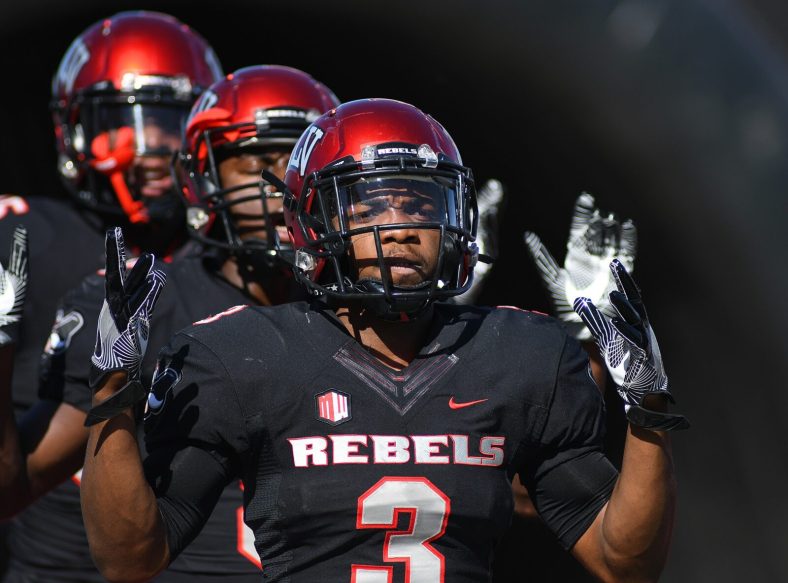
While the plan still needs vetting and approval by the Nevada Board of Regents, the Raiders and UNLV have reached a proposed agreement in principle on a lease for the new stadium in Las Vegas.
One of the final hurdles for the Las Vegas Stadium project to move forward without any delay is a lease agreement with UNLV on its use of the Raiders news stadium in Las Vegas, appears to be cleared as the team and representatives of the university have reached an agreement on a lease.
The draft agreement will be discussed, but not voted on, at the Board of Regents special meeting next week in Las Vegas.
Big day for Las Vegas. Excited to share our new home with the #LasVegasRaiders! pic.twitter.com/4IAKAickYN
— UNLV Football (@unlvfootball) March 27, 2017
Here are some highlights based on the summary released today, and the Las Vegas Raiders Report will discuss this, and the entire document, in the coming days.
Key takeaways from the Raiders LV Stadium Events Company, LLC, proposed lease agreement with UNLV:
- Use of the Stadium: UNLV will have use of the stadium for all football home games, and three other events it can determine. Those events can include things like graduation, a spring football game, or anything they would like. Limitations were not limited. UNLV is limited to two non-conference football games, per the agreement.
- UNLV Can Sell and Keep Premium Seating Revenue: One of the big issues for UNLV was the ability to raise revenue by selling premium suites and seating in the new facility. The agreement states: “UNLV has the right to sell licenses for a significant number of luxury suites and retain all revenue from such sales, excluding 22 ‘Owner’s Level’ suites and 8 other luxury suites. UNLV has the right to sell tickets for all club, loge and non-premium seats and retain all revenue from such sales.
- Scheduling: Here is one of the more interesting bits in the agreement. The summary specifically calls out the two non conference games UNLV is allowed to schedule under the lease. It names specifically “Power 5” conference games. The agreement states: “These non-conference games will focus on opponents in “Power 5” conferences and will have priority over Major Events (as defined in the Joint Use Agreement) not scheduled prior to UNLV’s request to schedule such non-conference games.”
- Rent: Since UNLV will be a tenant in the new stadium, they will be responsible for all operation cossts associated with the use of the facility, excluding fixed costs. It will operate on a “pass through” basis for them and Stadco. An interesting piece of this section discusses “right sizing” the stadium’s use for UNLV – which means closing/tarping off sections as its not anticipated UNLV could come even close to filling 65,000 seats for even big non-conference games played in the new facility. This has an operational impact on the stadium operation as configurations may change depending on the Rebels opponent for a specific game.
- Concessions: Net concession revenue from UNLV Events will belong to UNLV. Pretty straight forward. Stadco controls selection of the concession vendors, etc., per the larger stadium agreement. It also states: “UNLV may provide donated/free food and beverage to players, coaches, game day staff and on-field officials in designated areas.” This will save on come costs for UNLV as they won’t be forced to buy catering from the official concession provider of the new stadium.
- Parking: UNLV will have access to both onsite (which will be extremely limited) and offsite parking for use on game/event day. But, UNLV will only get to keep net revenue for parking onsite – they will receive zero revenue from any offsite parking sites. That revenue will go directly to Stadco.
- In-Stadium Advertising: Another big issue for UNLV to generate more revenue, the good news is the university will be able to revenue from their own sales. The proposal states: “UNLV has the right to sell temporary advertising and sponsorship opportunities within, on or about the stadium premises, including field boards, banners and audio/visual signage for display during UNLV Events and is entitled to all revenues from such advertising signage.” Since most of the new advertising will be digital LED boards, this was an easy ask. There are some complexities here we will address in a later post.
- Offset of Revenue: This is, in essence, a make-good provision by Stadco to replace revenue derived by the operation of Sam Boyd Stadium. “Annual compensation payments of up to $3.5 million from the Stadium Authority to offset revenue streams previously available at Sam Boyd Stadium, which revenue streams are either reduced or not available at the new stadium,” the proposal states.
- Artificial Turf: Although the stadium will use a natural grass surface for Raiders games, Stadco has agree to fund the purchase of a field turf surface for use during UNLV football games or other events. The proposal states: “Stadco, at its cost, will provide an artificial turf field for UNLV’s use, comparable to other NCAA Division I football facilities. Stadco will repair, maintain, store and switch out the artificial turf field at its expense. UNLV will be responsible for cost of obtaining, repairing, storing and switching out the midfield logo, end zones and other portions of the field containing customized “UNLV” or other home field markings. “
There are other details we will go over during future podcasts and stories in this space.
In the meantime, this is a great sign for both sides. There’s no question the Raiders and UNLV are forging a good and mutually beneficial relationship during the first phases of the stadium project.
We’ll be at the meeting next week and will bring you the latest news on the UNLV lease proposal with the Raiders.